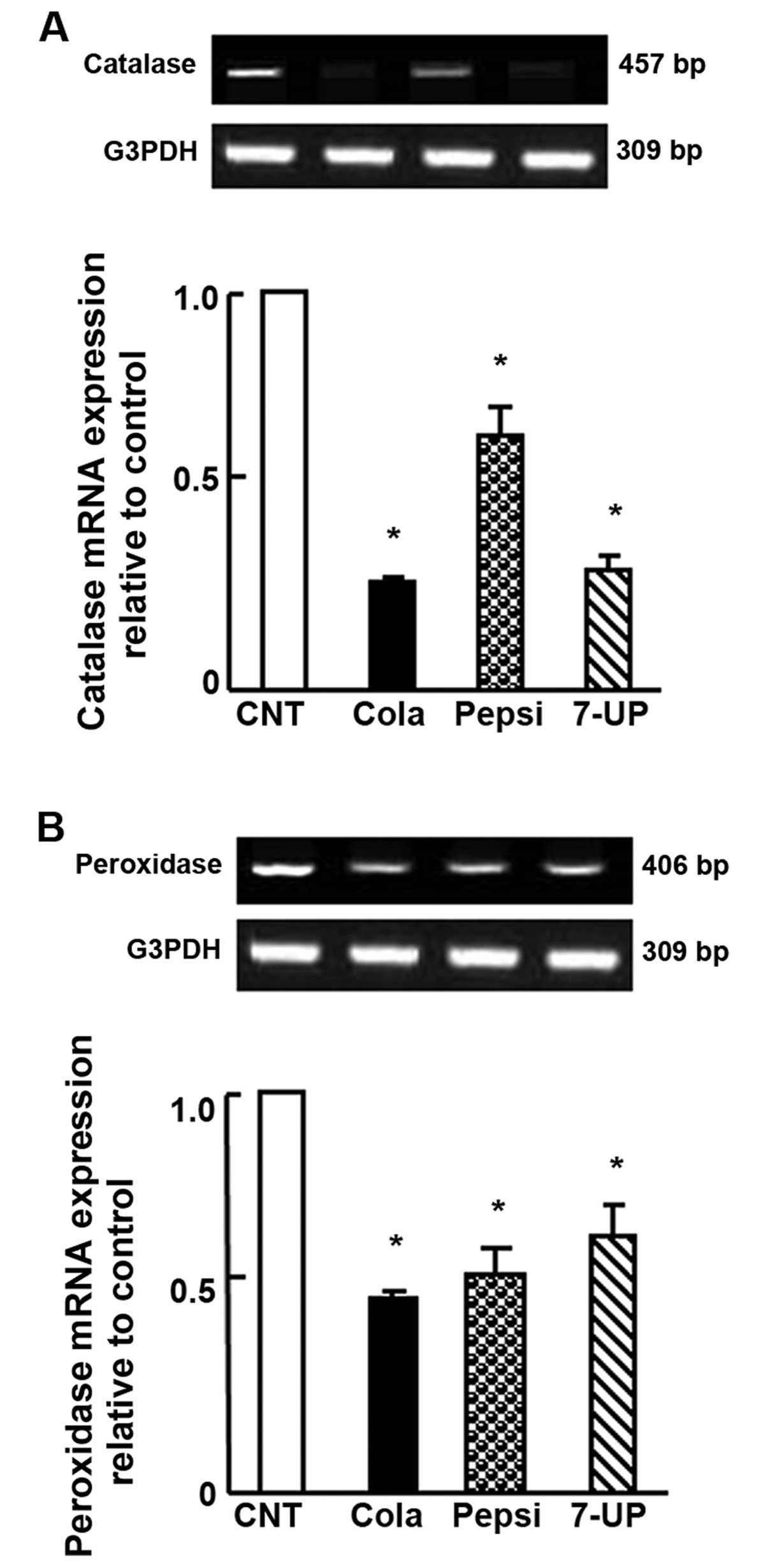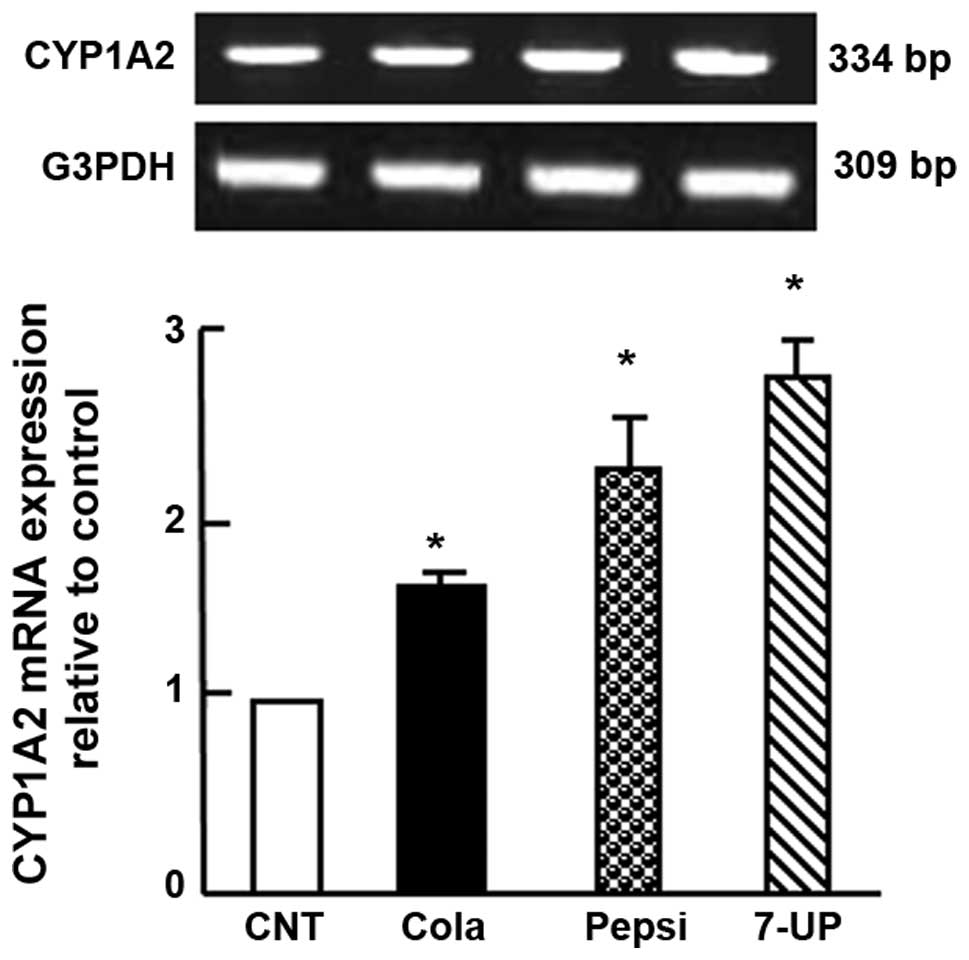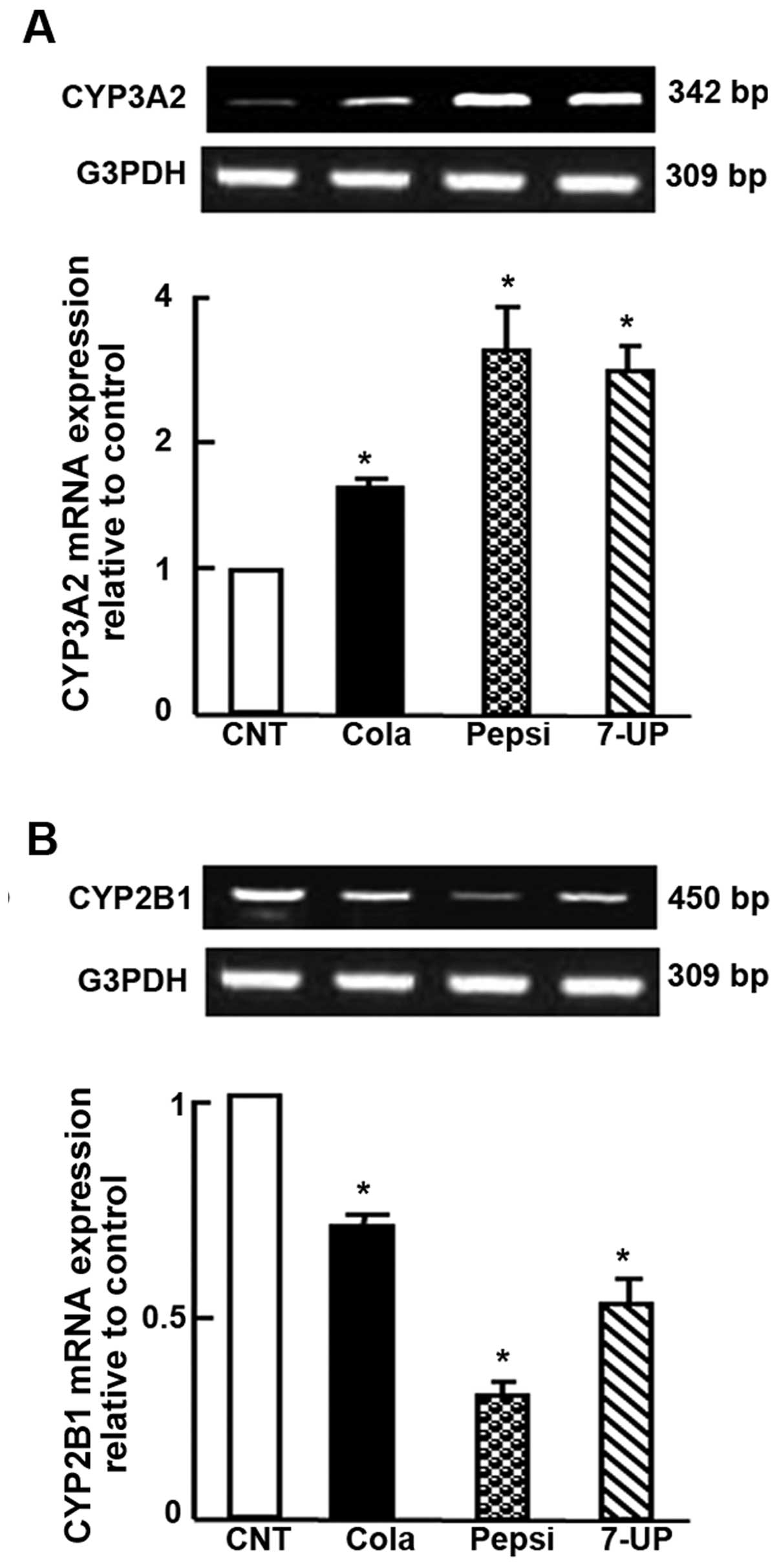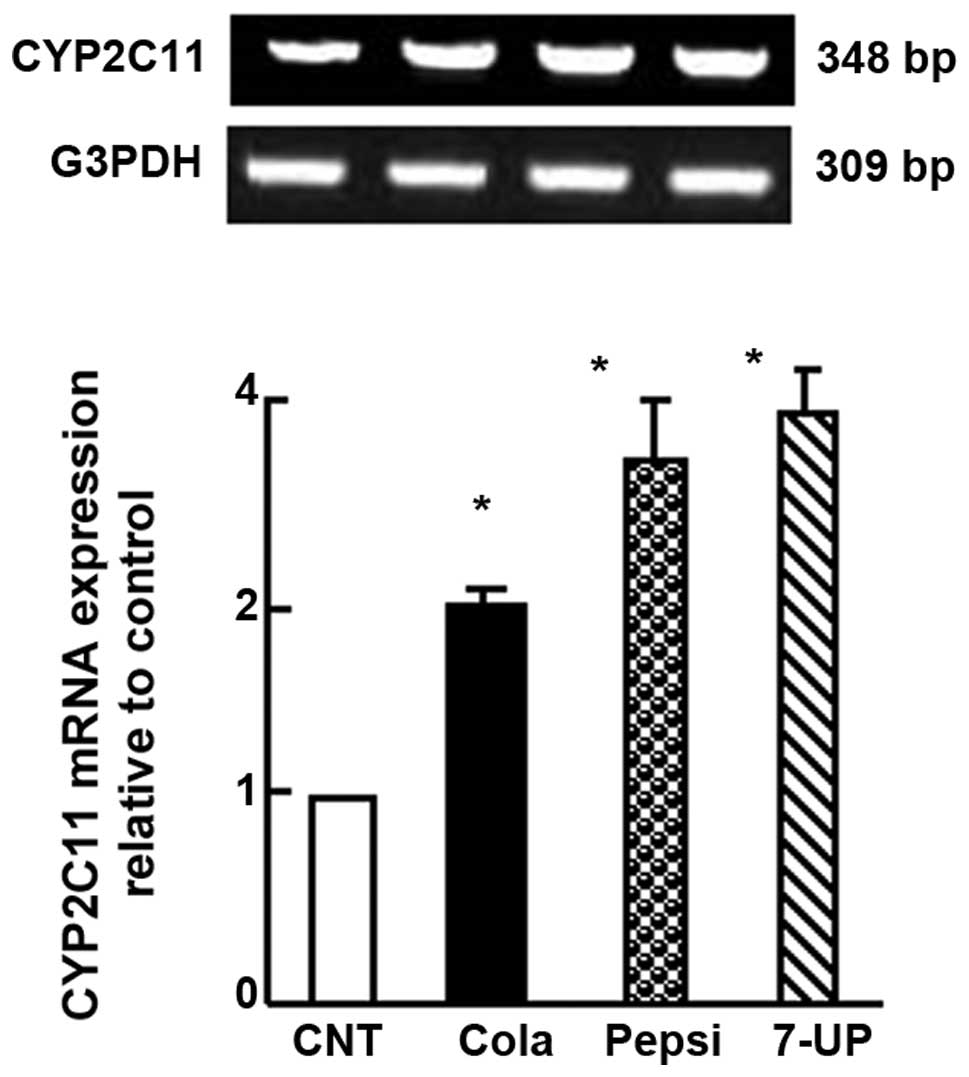|
1
|
Nielsen SJ and Popkin BM: Changes in
beverage intake between 1977 and 2001. Am J Prev Med. 27:205–210.
2004. View Article : Google Scholar : PubMed/NCBI
|
|
2
|
Adjene JO, Ezeoke JC and Nwose EU:
Histological effects of chronic consumption of soda pop drinks on
kidney of adult Wister rats. N Am J Med Sci. 2:215–217.
2010.PubMed/NCBI
|
|
3
|
Amato D, Maravilla A, García-Contreras F
and Paniagua R: Soft-drinks and health. Rev Invest Clin.
49:387–395. 1997.(In Spanish). PubMed/NCBI
|
|
4
|
Amato D, Maravilla A, Montoya C, Gaja O,
Revilla C, Guerra R and Paniagua R: Acute effects of soft drink
intake on calcium and phosphate metabolism in immature and adult
rats. Rev Invest Clin. 50:185–189. 1998.PubMed/NCBI
|
|
5
|
Rapuri PB, Gallagher JC, Kinyamu HK and
Ryschon KL: Caffeine intake increases the rate of bone loss in
elderly women and interacts with vitamin D receptor genotypes. Am J
Clin Nutr. 74:694–700. 2001.PubMed/NCBI
|
|
6
|
Swinburn BA, Caterson I, Seidell JC and
James WP: Diet, nutrition and the prevention of excess weight gain
and obesity. Public Health Nutr 7 (1A). 123–146. 2004.
|
|
7
|
Palmer JR, Boggs DA, Krishnan S, Hu FB,
Singer M and Rosenberg L: Sugar-sweetened beverages and incidence
of type 2 diabetes mellitus in African American women. Arch Intern
Med. 168:1487–1492. 2008. View Article : Google Scholar : PubMed/NCBI
|
|
8
|
Fung TT, Malik V, Rexrode KM, Manson JE,
Willett WC and Hu FB: Sweetened beverage consumption and risk of
coronary heart disease in women. Am J Clin Nutr. 89:1037–1042.
2009. View Article : Google Scholar : PubMed/NCBI
|
|
9
|
Santucci R, Levêque D and Herbrecht R:
Cola beverage and delayed elimination of methotrexate. Br J Clin
Pharmacol. 70:762–764. 2010. View Article : Google Scholar : PubMed/NCBI
|
|
10
|
Guengerich FP: Cytochrome p450 and
chemical toxicology. Chem Res Toxicol. 21:70–83. 2008. View Article : Google Scholar : PubMed/NCBI
|
|
11
|
Fowler S and Zhang H: In vitro evaluation
of reversible and irreversible cytochrome P450 inhibition: Current
status on methodologies and their utility for predicting drug-drug
interactions. AAPS J. 10:410–424. 2008. View Article : Google Scholar : PubMed/NCBI
|
|
12
|
Lazarou J, Pomeranz BH and Corey PN:
Incidence of adverse drug reactions in hospitalized patients: A
meta-analysis of prospective studies. JAMA. 279:1200–1205. 1998.
View Article : Google Scholar : PubMed/NCBI
|
|
13
|
Lee JH, Suh OK and Lee MG: Pharmacokinetic
changes in drugs during protein-calorie malnutrition: Correlation
between drug metabolism and hepatic microsomal cytochrome P450
isozymes. Arch Pharm Res. 27:693–712. 2004. View Article : Google Scholar : PubMed/NCBI
|
|
14
|
Platt DE, Ghassibe-Sabbagh M, Salameh P,
Salloum AK, Haber M, Mouzaya F, Gauguier D, Al-Sarraj Y, El-Shanti
H, Zalloua PA, et al: Caffeine Impact on Metabolic Syndrome
Components Is Modulated by a CYP1A2 Variant. Ann Nutr Metab.
68:1–11. 2016. View Article : Google Scholar : PubMed/NCBI
|
|
15
|
El-Terras A, Soliman MM, Alkhedaide A,
Attia HF, Alharthy A and Banaja AE: Carbonated soft drinks induce
oxidative stress and alter the expression of certain genes in the
brains of Wistar rats. Mol Med Rep. 13:3147–3154. 2016.PubMed/NCBI
|
|
16
|
Soliman MM, Baiomy AA and Yassin MH:
Molecular and histopathological study on the ameliorative effects
of curcumin against lead acetate-induced hepatotoxicity and
nephrototoxicity in Wistar rats. Biol Trace Elem Res. 167:91–102.
2015. View Article : Google Scholar : PubMed/NCBI
|
|
17
|
Hensley K, Robinson KA, Gabbita SP,
Salsman S and Floyd RA: Reactive oxygen species, cell signaling,
and cell injury. Free Radic Biol Med. 28:1456–1462. 2000.
View Article : Google Scholar : PubMed/NCBI
|
|
18
|
Alkhedaide A, Soliman MM, Salah-Eldin AE,
Ismail TA, Alshehiri ZS and Attia HF: Chronic effects of soft drink
consumption on the health state of Wistar rats: A biochemical,
genetic and histopathological study. Mol Med Rep. 13:5109–51017.
2016.PubMed/NCBI
|
|
19
|
Niki E: Lipid peroxidation: Physiological
levels and dual biological effects. Free Radic Biol Med.
47:469–484. 2009. View Article : Google Scholar : PubMed/NCBI
|
|
20
|
Horton AA and Fairhurst S: Lipid
peroxidation and mechanisms of toxicity. Crit Rev Toxicol.
18:27–79. 1987. View Article : Google Scholar : PubMed/NCBI
|
|
21
|
Blair IA: DNA adducts with lipid
peroxidation products. J Biol Chem. 283:15545–15549. 2008.
View Article : Google Scholar : PubMed/NCBI
|
|
22
|
Łuczaj W and Skrzydlewska E: DNA damage
caused by lipid peroxidation products. Cell Mol Biol Lett.
8:391–413. 2003.PubMed/NCBI
|
|
23
|
Oberley TD and Oberley LW: Antioxidant
enzyme levels in cancer. Histol Histopathol. 12:525–535.
1997.PubMed/NCBI
|
|
24
|
Saydam N, Kirb A, Demir O, Hazan E, Oto O,
Saydam O and Güner G: Determination of glutathione, glutathione
reductase, glutathione peroxidase and glutathione S-transferase
levels in human lung cancer tissues. Cancer Lett. 119:13–19. 1997.
View Article : Google Scholar : PubMed/NCBI
|
|
25
|
Zaher H, Buters JT, Ward JM, Bruno MK,
Lucas AM, Stern ST, Cohen SD and Gonzalez FJ: Protection against
acetaminophen toxicity in CYP1A2 and CYP2E1 double-null mice.
Toxicol Appl Pharmacol. 152:193–199. 1998. View Article : Google Scholar : PubMed/NCBI
|
|
26
|
Faber MS, Jetter A and Fuhr U: Assessment
of CYP1A2 activity in clinical practice: Why, how, and when? Basic
Clin Pharmacol Toxicol. 97:125–134. 2005. View Article : Google Scholar : PubMed/NCBI
|
|
27
|
Gonzalez FJ: Molecular genetics of the
P-450 superfamily. Pharmacol Ther. 45:1–38. 1990. View Article : Google Scholar : PubMed/NCBI
|
|
28
|
Gibson GG, Plant NJ, Swales KE, Ayrton A
and El-Sankary W: Receptor-dependent transcriptional activation of
cytochrome P4503A genes: Induction mechanisms, species differences
and interindividual variation in man. Xenobiotica. 32:165–206.
2002. View Article : Google Scholar : PubMed/NCBI
|
|
29
|
Sumida A, Kinoshita K, Fukuda T, Matsuda
H, Yamamoto I, Inaba T and Azuma J: Relationship between mRNA
levels quantified by reverse transcription-competitive PCR and
metabolic activity of CYP3A4 and CYP2E1 in human liver. Biochem
Biophys Res Commun. 262:499–503. 1999. View Article : Google Scholar : PubMed/NCBI
|
|
30
|
Nedelcheva V and Gut I: P450 in the rat
and man: Methods of investigation, substrate specificities and
relevance to cancer. Xenobiotica. 24:1151–1175. 1994. View Article : Google Scholar : PubMed/NCBI
|
|
31
|
Lamba JK, Lin YS, Thummel K, Daly A,
Watkins PB, Strom S, Zhang J and Schuetz EG: Common allelic
variants of cytochrome P4503A4 and their prevalence in different
populations. Pharmacogenetics. 12:121–132. 2002. View Article : Google Scholar : PubMed/NCBI
|
|
32
|
Nelson DR, Koymans L, Kamataki T, Stegeman
JJ, Feyereisen R, Waxman DJ, Waterman MR, Gotoh O, Coon MJ,
Estabrook RW, et al: P450 superfamily: Update on new sequences,
gene mapping, accession numbers and nomenclature. Pharmacogenetics.
6:1–42. 1996. View Article : Google Scholar : PubMed/NCBI
|
|
33
|
Shayeganpour A, El-Kadi AO and Brocks DR:
Determination of the enzyme(s) involved in the metabolism of
amiodarone in liver and intestine of rat: The contribution of
cytochrome P450 3A isoforms. Drug Metab Dispos. 34:43–50. 2006.
View Article : Google Scholar : PubMed/NCBI
|
|
34
|
Christians U: Transport proteins and
intestinal metabolism: P-glycoprotein and cytochrome P4503A. Ther
Drug Monit. 26:104–106. 2004. View Article : Google Scholar : PubMed/NCBI
|
|
35
|
Matsuda H, Kinoshita K, Sumida A,
Takahashi K, Fukuen S, Fukuda T, Takahashi K, Yamamoto I and Azuma
J: Taurine modulates induction of cytochrome P450 3A4 mRNA by
rifampicin in the HepG2 cell line. Biochim Biophys Acta.
1593:93–98. 2002. View Article : Google Scholar : PubMed/NCBI
|
|
36
|
Tsuda S, Egawa T, Kitani K, Oshima R, Ma X
and Hayashi T: Caffeine and contraction synergistically stimulate
5′-AMP-activated protein kinase and insulin-independent glucose
transport in rat skeletal muscle. Physiol Rep. 3:e125922015.
View Article : Google Scholar : PubMed/NCBI
|
|
37
|
Yang H, Garzel B, Heyward S, Moeller T,
Shapiro P and Wang H: Metformin represses drug-induced expression
of CYP2B6 by modulating the constitutive androstane receptor
signaling. Mol Pharmacol. 85:249–260. 2014. View Article : Google Scholar : PubMed/NCBI
|
|
38
|
Mo SL, Liu YH, Duan W, Wei MQ, Kanwar JR
and Zhou SF: Substrate specificity, regulation, and polymorphism of
human cytochrome P450 2B6. Curr Drug Metab. 10:730–753. 2009.
View Article : Google Scholar : PubMed/NCBI
|
|
39
|
Iber H, Li-Masters T, Chen Q, Yu S and
Morgan ET: Regulation of hepatic cytochrome P450 2C11 via cAMP:
Implications for down-regulation in diabetes, fasting, and
inflammation. J Pharmacol Exp Ther. 297:174–180. 2001.PubMed/NCBI
|
|
40
|
Wang H, Guan W, Yang W, Wang Q, Zhao H,
Yang F, Lv X and Li J: Caffeine inhibits the activation of hepatic
stellate cells induced by acetaldehyde via adenosine A2A receptor
mediated by the cAMP/PKA/SRC/ERK1/2/P38 MAPK signal pathway. PLoS
One. 9:e924822014. View Article : Google Scholar : PubMed/NCBI
|
|
41
|
Morgan NG, Blackmore PF and Exton JH:
Age-related changes in the control of hepatic cyclic AMP levels by
alpha 1- and beta 2-adrenergic receptors in male rats. J Biol Chem.
258:5103–5109. 1983.PubMed/NCBI
|
|
42
|
Yasuda K, Ueno S, Ueda E, Nishikawa M,
Takeda K, Kamakura M, Ikushiro S and Sakaki T: Influence of sesamin
on CYP2C-mediated diclofenac metabolism: In vitro and in vivo
analysis. Pharmacol Res Perspect. 3:e001742015. View Article : Google Scholar : PubMed/NCBI
|













